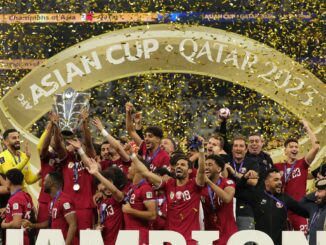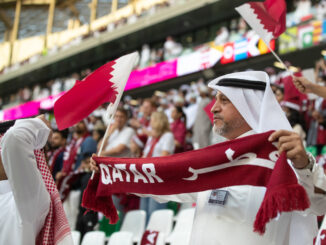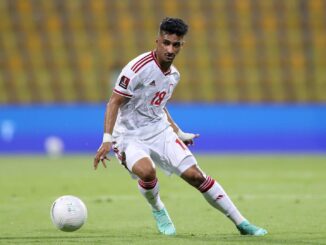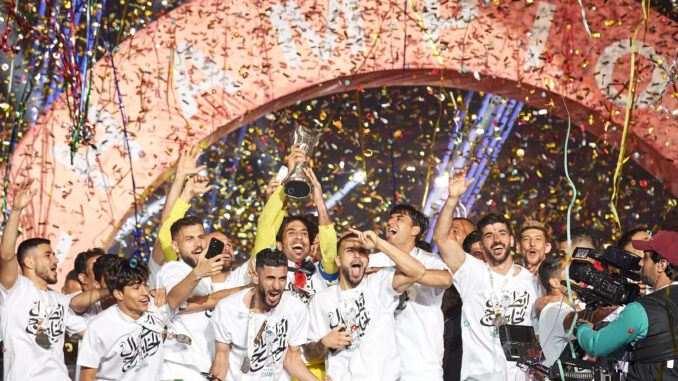
Agony, followed by ecstasy. The very best and worst that football can bring to a country will likely share the spotlight in defining the 25th edition of the Gulf Cup.
While hosts Iraq can look back on a historic triumph, their first Gulf Cup title in 35 years, matters off-the-pitch may take precedence as the dust settles on a tumultuous tournament.
Following a three-decade FIFA ban, the last two weeks had gone a significant distance to proving Iraq is truly ready to host international football once again. However, following Iraq’s emotional passage through to the final, euphoria and hope quickly turned to disaster and turmoil in a matter of a few hours.
Some ten hours in fact, prior to kick off, large crowds, reportedly upwards of 250,000 hopeful spectators, descended on the final venue – the Basra International Stadium – irrespective of the possibility of acquiring a ticket to an already sold-out spectacle that could’ve been filled five times over.
In the ensuing panic and absent mindedness, four people lost their lives and at least 80 were recorded as injured in a sickening stampede and crush outside the stadium. While the resulting calls for calm and level headiness dispersed the heavy crowds within minutes, the tragedy went on to cast a lengthy shadow over what was supposed to be the glorious pinnacle of a tournament that reintroduced Iraqi football to the world.
It must be said, the sight of 65,000 home fans, impassioned, in unison and proud of their national team, were the real star attraction of a tournament that admittedly rarely got out of second gear on the pitch. While the football may have struggled to gain a similar traction, the sights and sounds of a sell-out Basra crowd belting out the Iraqi national anthem throughout the tournament will live long in the memory.
While the final still went ahead as planned, both on time and in Basra, following immediate rumours that the AGFF would move the match to a neutral venue later in the week, the passion of a home Iraqi final, their first for 10 years, somewhat lost its optimism ahead of kick-off.
A tournament that started with so much promise, in front of FIFA president Gianni Infantino no less; the fear that the final day’s events will now potentially overshadow the last few weeks of action is growingly apparent for those of us desperate to see international football return to Iraq on a permanent basis.
A fitting finale to an emotionally draining two weeks
From a footballing standpoint, Iraq indeed produced a fitting ending to a tournament admittedly hamstrung by mitigating factors. 3-2 victors over Oman following a thrilling extra-time seesaw that toyed with the emotions of a home crowd, who may have questioned the value of football only hours earlier but were sent into raptures through Manaf Younis’ last minute headed winner.
The familiar fragility of this Iraq team, much like the wider tournament, was an all too predictable tale of a team living on the edge throughout their campaign. New Spanish coach Jesus Casas promised a reversion to a more attractive, tiki-taka style, emulating his motherland; yet for his short time in the role, he merely seemed capable of guiding the momentum of a typically Iraq-esque performance.
Thriving off the sell out crowd, and their all-too-often physical opponents, Iraq’s capability to raise their game in the pressure moments eventually pulled them over the line. Following a goalless and tense opener against Oman, the side they would go on to conclude the tournament against, the turning point came in a torrential downpour against one of the pre-tournament favourites, Saudi Arabia.
While the weather was turgid and the pitch unplayable in parts, the crowd again played their part in upping the energy and work-rate of their players. Star man of the tournament Ibrahim Bayesh netted the decisive opener, his first of three at the Gulf Cup; a replica in many ways to his final effort against Oman, with a celebration that inspired the whole of Basra.
From that point their resolve, spurred on by the atmosphere, became their calling card; no sign of the aesthetics desired by Casas maybe, but heart to prove their worth on an international stage which continues to hold a hosting ban.
They were able to benefit from a full-strength squad, yet while there were commanding performances from a host regular starters – the commanding Mustafa Nadhim, the now bullish and in form Ayman Hussein and the creativity of Amjad Attwan in midfield – in their newer faces – midfield anchor Amir Al-Ammari, and younger guns Hassan Abdulkareem and Hussein Ammar, who impressed at last year’s U23 Asian Cup – the team grew to resemble a much more balanced unit.
While the aftermath will focus on the significance of the victory and the assessment over their hosting, Casas will already be looking towards next year’s Asian Cup as a yard stick of his progress in charge of a team already starting to resemble their full potential, escaping the regular pitfalls of their recent past.
The dramatic conclusion to this Gulf Cup did have a lot to do with Oman, however, a team looking to crown their recent rise of the last couple of years with a return to the title they last clinched five years ago under the late Pim Verbeek.
Branko Ivankovic, the man who inspired near miracles in World Cup qualification two years ago, once again rejigged an already defensively astute setup, into an effective counter outfit. Deploying an unusual, but highly effective low block, with three initial midfield shields, they nullified most of their opposition, including at times Iraq, on their way to the final, only to pounce in the dying embers of each encounter.
Embed from Getty ImagesHalf of their eight goals in Basra, came after the 83rd minute; two of which clinched crucial results against Saudi Arabia and Bahrain ahead of the final.
Driving performances from Jameel Al-Yahmadi, the fulcrum to Ivankovic’s quick-pounce counter threat and arguable goal of the tournament winner for his late effort against Bahrain, and Salaah Al-Yahyaei, the creative playmaker behind the front two, were the key highlights; yet the work-rate of frontman Rabia Al-Alawi, and young midfielder, and namesake Arshad Al-Alawi was also notable in the side’s tactical execution.
They were distinctly second best in the final, but ultimately they were a stoppage time away from taking Iraq to penalties. As they were in World Cup qualification, against the likes of Japan and Australia, Oman have not just become a flash in the pan, but a consistent, stubborn and growingly effective challenger for this upcoming cycle.
Mixed feelings for 2023’s nearly men
As we spoke ahead of the tournament, this edition of the Gulf Cup was presented as an afterthought on the pitch, given its condensed scheduling just weeks following the World Cup in neighbouring Qatar, and the increasing strains of fixed FIFA windows, which stripped many of the competition of their star players.
One of the key positives though, a full-strength Bahrain did make significant inroads; making it to a third successive Gulf Cup semi-final, just falling short of retaining their 2019 title, having lost to Oman in the last four.
For Helio Sousa’s team, there were many positives to take away from the tournament, alluding to a promising few years ahead. Sousa’s usual squad rotation may have ultimately cost them some cohesion in their semi-final defeat, but it did illustrate their strength and depth, especially in attacking positions.
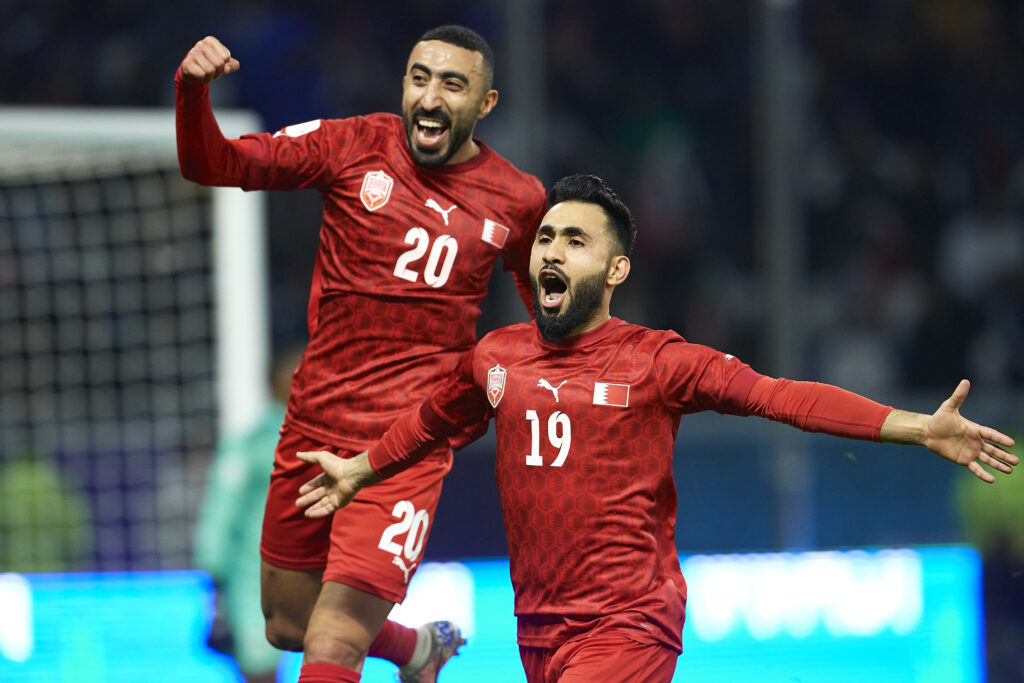
Imposing striker Abdullah Yusuf now looks an experienced leading man, a mature focal point that commands Sousa’s attacking approach. The support of Kamil Al-Aswad and Mahdi Al-Humaidan, who at times both replicated their impressive domestic form as Yusuf’s foil, and while this tournament may prove to be ultimately a missed opportunity, it does promise an element of hope once wider Asian qualification returns this Autumn.
While Bahrain are hitting their prime, this Gulf Cup was very much seen as a testing ground for the coming cycle for Qatar and Saudi Arabia, a month on from their contrasting campaigns at the World Cup.
Qatar selected ten of the squad that crashed out early at their host event back in November; promising a point to prove on the run up to the Gulf Cup, but refreshingly resembling a team that had put to bed their worries.
While the pressure seemed to be off, there were clear organisational difficulties. A week on from Felix Sanchez’s exit, caretaker coach Bruno Pinheiro adopted a different approach, one that was more direct and had shifted formation whilst trying out some of the next generation of talent.
While we saw flashes of talent from the likes of wideman Amro Sirag and imposing centre back Jaseem Jaber, consistency, especially from the more experienced players in central midfield – Mohammed Waad and Assim Madibo – seemed to be lacking.
In their somewhat fortunate run to the semi-finals, before the hosts eased past them, Qatar’s highlight came through the late equaliser against UAE in the group stages which ensured their progression.
20-year-old Tameem Mansour’s first international goal was both significant on and off the pitch, as he emulated his father, Qatari legend Mansour Muftah, who scored Qatar’s only goal at the same stage in a Gulf Cup match against the same opposition in 1979.
Mansour, and others, represent the future of the national team at the same time when feeling over the existing squad grows sour. With Pinheiro likely to return to his role with the U23s, a new coach, potentially Carlos Queiroz, will have a lot to do to turn around the squad ahead of a return to the Gold Cup this summer, following the news of senior player suspensions that will no doubt linger around the set up in the months ahead.
Such pessimism isn’t felt over in Saudi Arabia, but that mainly relates to the lack of senior squad representation in Iraq. Under-23 boss Saad Al-Shehri’s ramshackle mix of youth and older B-players rarely looked a team that could challenge in Iraq and secure an unlikely third continental title for the coach in little under a year.
There were plus points: Riyadh Sharahilli, the only player to be selected that did travel to the World Cup, commanded an interesting midfield trio with under-21 starlets Musab Al-Juwayr and Awad Al-Nashri, while highly rated keeper Nawaf Al-Qidi and journeyman Sumayhan Al-Nabit both had their moments of success, in what were their national team debuts.
In the end mentality was their undoing; collapsing under the admittedly horrendous torrential rain in Basra against the hosts. While Al-Shehri bemoaned the unfit conditions following defeat, in having their destiny in their own hands going into the final match, a placid showing against Oman didn’t exactly help his argument.
After a few years of undisputed success, Saudi Arabia are granted a forgettable tournament now and again. It’ll be interesting to see though how many of these players will resurface in the coming year.
Embed from Getty ImagesThe Emirates car crash continues
While others had high hopes going into this Gulf Cup, expectations of a renaissance in Emirati football remain firmly unfulfilled. Following a missed opportunity in World Cup qualification, Argentine coach Rodolfo Arruabarrena did once allude to green shoots of revival in their continental playoffs that finalised the cycle.
While the talent at his disposal remains of significant quality, at least regionally; Khalid Eisa in goal, centre back Khalifa Al-Hammadi and central midfielder Majed Hassan continue to offer a solid spine, while Caio Canedo, Fabio Lima and Harib Abdalla form an attacking trio the envy of many across Asia; Arruabarrena’s ability to gel this squad and inject confidence remains distinctly lost.
The removal of leading goalscorer Ali Mabkhout for “technical and tactical reasons” on the eve of the tournament looks ever more puzzling for a team that only scored two goals in three games, one being a stoppage time consolation for Sebastian Tagliabue, an evergreen 38-years of age next month. This isn’t a team in noticeable transition anymore, it’s a team that has crashed and is awaiting rescue.
They weren’t alone in that position. Group B opponents Kuwait similarly failed at the first hurdle, despite a late 1-0 win over their Emirati neighbours. This was yet another new start for the Al-Azraq, with Rui Bento taking charge in August, and while there were glimmers of promise, a final day struggle against Bahrain wasn’t enough to climb over the line.
Finally, the most pleasing glimmer of hope came in the unlikely form of Yemen. While they failed once again to register a Gulf Cup victory, under new coach Miroslav Soukup they were able to score their first international goals in over three years as they threatened to upset finalists-to-be Oman, taking a 2-1 lead on that infamous waterlogged Basra pitch, before Ivankovic’s side clawed their way back to win 3-2.
Yemen also produced the most bizarre event of the tournament, in their underplayed clash with Saudi Arabia – two nations it must be reminded are currently in military conflict with one another – when players switched shin guards whilst facilitating a substitution. A subtle but noticeable indication of the continued financial struggles of the Yemeni national team heading into a new four-year cycle.
All in all, the 2023 Gulf Cup will not go down in the memory as a classic, unless you keep the last five minutes of extra-time firmly in mind.
What was significant, however, was the rebound of Iraqi football, responding to an unfit international ban with humility and passion for the sport we all love.
However, while FIFA had an open goal in reversing the ban only days ago, it’ll now remain to be seen how a tragic end to the tournament off the pitch, may go on to have the greatest impact on Iraq’s footballing future.
Photo: twitter/AGCFF
Listen to the latest The Asian Game Podcast


